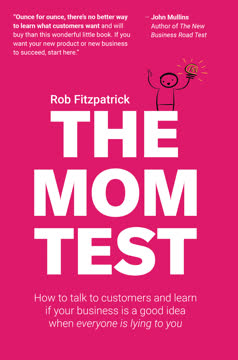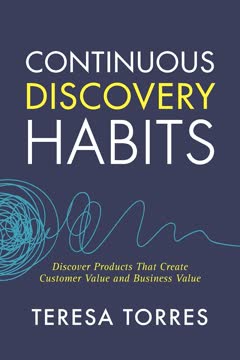重点摘要
1. 数据驱动的决策对于初创企业的成功至关重要
如果你不能衡量它,你就无法管理它。
衡量以成功。 在初创企业的世界里,直觉和假设可能会误导人。数据驱动的决策使企业家能够快速高效地验证想法、识别问题并优化解决方案。通过收集和分析相关指标,初创企业可以:
- 识别并专注于业务中最关键的方面
- 基于证据而非猜测做出明智的决策
- 在面对挑战时更有效地适应和转变
避免虚荣指标。 并非所有数据都是平等的。初创企业必须专注于能够带来实际业务价值的可操作指标,而不是那些看起来令人印象深刻但并不转化为有意义进展的虚荣指标。虚荣指标的例子包括:
- 总注册用户数(不考虑活跃用户)
- 页面浏览量(不考虑转化率)
- 总筹资额(不考虑烧钱率和跑道)
2. 唯一重要的指标(OMTM)集中精力并推动增长
在任何给定时间,有一个指标是你最应该关心的。
激光聚焦。 OMTM 概念鼓励初创企业识别并专注于当前阶段和商业模式中最重要的单一指标。这种方法:
- 使整个团队围绕一个共同目标对齐
- 简化决策过程
- 促进快速迭代和改进
明智选择。 OMTM 应该是:
- 可操作的:直接受你的行动影响
- 可比较的:随时间或与竞争对手相比可衡量
- 易于理解的:组织中的每个人都能轻松掌握
- 可变的:随着业务增长和优先级变化而演变
不同阶段的 OMTM 例子:
- 想法验证:问题访谈完成率
- MVP 测试:用户参与率
- 增长:病毒系数
- 收入:客户终身价值(CLV)与客户获取成本(CAC)比率
3. 精益分析阶段引导初创企业从想法到规模化
精益创业实际上是让你在正确的时间、以正确的心态专注于正确的事情。
五个增长阶段。 精益分析框架概述了初创企业通常经历的五个不同阶段:
- 同理心:理解客户问题和需求
- 粘性:创建一个能吸引用户的产品
- 病毒性:通过口碑和推荐促进用户增长
- 收入:将产品或服务货币化
- 规模化:将业务扩展到新市场或新细分市场
阶段特定的关注点。 每个阶段都有其自身的优先事项、挑战和关键指标。通过了解自己处于哪个阶段,初创企业可以:
- 设定适当的目标和期望
- 更有效地分配资源
- 避免过早扩展或错误的努力方向
初创企业应专注于掌握每个阶段,然后再进入下一个阶段,以确保可持续增长的坚实基础。
4. 不同的商业模式需要不同的关键指标
你需要弄清楚你所处的业务类型,然后弄清楚对这种业务类型重要的数字。
定制分析。 不同的商业模式具有独特的特征和成功因素。书中概述了六种常见的商业模式及其相关的关键指标:
- 电子商务:转化率、平均订单价值、客户获取成本
- SaaS:月度经常性收入、流失率、客户终身价值
- 移动应用:下载率、日活跃用户、每用户平均收入
- 媒体网站:页面浏览量、网站停留时间、广告点击率
- 用户生成内容:内容创建率、参与漏斗、病毒性
- 双边市场:流动性、匹配率、交易量
模型特定的优化。 通过专注于与其商业模式最相关的指标,初创企业可以:
- 更准确地识别改进领域
- 根据行业标准进行绩效基准测试
- 做出与其特定目标和挑战一致的数据驱动决策
5. 设定现实的基准对于衡量进展至关重要
除非你有一条基准线,否则你不知道自己做得好还是不好。
成功的基准。 为关键指标设定现实的基准和目标,使初创企业能够:
- 客观地衡量进展
- 设定可实现的目标
- 识别何时需要转变或坚持
行业标准。 虽然每个初创企业都是独特的,但行业基准可以提供有价值的背景:
- 电子商务转化率:大多数网站为1-3%,顶级表现者为7-15%
- SaaS 流失率:早期阶段每月5-7%,成熟业务为1-2%
- 移动应用保留率:30天后为40-60%,90天后为20-40%
持续改进。 随着业务的发展和市场条件的变化,定期重新评估和调整基准。这确保了目标既具有挑战性又可实现。
6. 客户开发和持续学习是基础
不要卖你能做的东西;做你能卖的东西。
倾听和学习。 客户开发是验证假设和优化产品市场契合度的关键过程。关键原则包括:
- 进行问题访谈以了解客户痛点
- 进行解决方案访谈以验证拟议的产品
- 构建最小可行产品(MVP)以测试关键假设
快速迭代。 构建-测量-学习反馈循环对于持续改进至关重要:
- 构建:创建产品或功能的最小版本
- 测量:收集用户行为和反馈数据
- 学习:分析结果并生成新见解
- 重复:利用学习成果指导下一次迭代
这种方法使初创企业能够:
- 最小化在未经验证的想法上浪费的资源
- 快速适应不断变化的市场条件
- 开发真正与客户产生共鸣的产品
7. 分析必须与直觉和适应性平衡
数据驱动的机器优化,如果不受人类判断的调节,可能会引发问题。
人性因素。 虽然数据至关重要,但成功的初创企业也依赖于:
- 创始人的直觉和行业专业知识
- 来自客户和团队成员的定性反馈
- 面对意外挑战或机会的适应能力
避免分析瘫痪。 过度依赖数据可能导致:
- 由于决策缓慢而错失机会
- 无法超越当前指标进行创新
- 忽视重要但难以衡量的因素
平衡方法。 将数据驱动的决策与以下内容结合:
- 定期的客户互动和同理心建设练习
- 跨职能团队讨论以全面解释数据
- 灵活性以实验非常规想法
8. 精益分析也适用于企业和内部创业者
软件吞噬一切。
超越初创企业。 精益分析原则可以应用于各种环境:
- 寻求创新的成熟企业
- 在大型组织内推动变革的内部创业者
- 优化影响力的非营利组织
克服挑战。 将精益分析适应于大型组织需要:
- 高层管理的支持
- 与现有业务目标的明确对齐
- 谨慎处理内部政治和利益相关者管理
对企业的好处:
- 更快的创新周期
- 改进的资源分配
- 数据驱动的文化转变
内部创业者策略:
- 从小规模的集中实验开始
- 快速展示价值以获得支持
- 利用现有资源和不公平优势
- 在组织约束下平衡颠覆性创新
通过在不同环境中应用精益分析原则,各种规模的组织都可以培养持续改进和数据驱动决策的文化。
最后更新日期:
FAQ
What's Lean Analytics about?
- Data-Driven Decisions: Lean Analytics by Alistair Croll and Benjamin Yoskovitz focuses on using data to make informed decisions in startups, providing a framework for understanding which metrics matter at different stages.
- Stages of Growth: It outlines five key stages—Empathy, Stickiness, Virality, Revenue, and Scale—each with specific metrics to track, helping entrepreneurs focus on what matters most.
- Actionable Insights: The book offers practical advice and case studies to illustrate how to apply analytics effectively, helping startups avoid common pitfalls and make better strategic choices.
Why should I read Lean Analytics?
- Improve Startup Success: The book provides a data-driven approach that can significantly enhance the chances of startup success by identifying the right metrics to track.
- Framework for Measurement: It offers a clear framework for measuring key performance indicators (KPIs) relevant to your business model, focusing on metrics that truly matter.
- Real-World Examples: Numerous case studies from successful startups make the concepts relatable and easier to understand, illustrating how analytics can drive growth and innovation.
What are the key takeaways of Lean Analytics?
- One Metric That Matters: Focus on a single key metric that drives your business forward, helping streamline efforts and avoid distractions from less impactful metrics.
- Avoid Vanity Metrics: Distinguish between actionable metrics that drive behavior and decision-making, and vanity metrics that may look good but do not provide real insights.
- Iterative Learning: Emphasizes a build-measure-learn cycle, where startups continuously test hypotheses and iterate based on data, fostering a culture of experimentation and adaptability.
What are the stages of growth outlined in Lean Analytics?
- Empathy Stage: Focuses on understanding customer problems and validating whether they are worth solving through interviews and qualitative feedback.
- Stickiness Stage: Aims to build a product that users find engaging and want to return to, with metrics like daily active users and retention rates becoming crucial.
- Virality Stage: Leverages word-of-mouth and referrals to grow the user base, emphasizing the importance of creating a product that users want to share.
- Revenue Stage: Concentrates on monetization strategies and optimizing revenue streams, understanding customer lifetime value and acquisition costs.
- Scale Stage: Involves expanding the business and reaching new markets, focusing on scaling operations and maintaining growth momentum.
What is the One Metric That Matters (OMTM) in Lean Analytics?
- Critical Focus Metric: The OMTM is the single most important metric that a startup should focus on at any given time, maintaining clarity and direction in analytics efforts.
- Dynamic Nature: It changes as the startup progresses through different stages, shifting from user acquisition metrics to retention metrics as the product matures.
- Guides Decision-Making: Concentrating on the OMTM helps entrepreneurs make more informed decisions and prioritize actions that drive growth.
How does Lean Analytics define actionable metrics?
- Actionable vs. Vanity Metrics: Actionable metrics directly influence decision-making and behavior, while vanity metrics may look impressive but do not provide real insights.
- Examples of Actionable Metrics: Metrics like conversion rates, customer acquisition costs, and churn rates inform strategic decisions and help understand business health.
- Importance of Context: Metrics should be contextualized within the business model, understanding how they relate to overall goals is crucial for effective analysis.
What is the Lean Canvas and how is it used in Lean Analytics?
- Visual Business Model: The Lean Canvas is a one-page visual tool to outline a business model, including sections for problems, solutions, key metrics, and unique value propositions.
- Focus on Risks: It helps identify the riskiest parts of a business model, allowing entrepreneurs to prioritize efforts and validate assumptions before heavy investment.
- Continuous Updates: Meant to be a living document that evolves as the business grows, entrepreneurs should regularly revisit and update it based on new insights and data.
What is the Problem-Solution Canvas mentioned in Lean Analytics?
- Tool for Focus: A two-page document designed to help startups maintain focus on their key problems and solutions, encouraging teams to prioritize issues and track progress.
- Weekly Updates: Founders are encouraged to fill out the canvas weekly, fostering accountability and keeping the team aligned on objectives.
- Hypothesized Solutions: Includes a section for hypothesized solutions, allowing teams to experiment and measure the effectiveness of their proposed fixes.
How can I apply the concepts from Lean Analytics to my startup?
- Identify Your Stage: Determine which stage of growth your startup is in and focus on the relevant metrics for that stage to guide your analytics efforts.
- Use the Lean Canvas: Create and regularly update a Lean Canvas to outline your business model and identify key risks, staying focused on what matters most.
- Establish Your OMTM: Define your One Metric That Matters for your current stage and ensure all efforts are aligned with improving that metric.
- Iterate and Experiment: Embrace a culture of experimentation by continuously testing hypotheses and iterating based on data, fostering learning and adaptability.
What are some common pitfalls in using analytics according to Lean Analytics?
- Overemphasis on Data: Entrepreneurs can become overly focused on data, leading to analysis paralysis; balance data-driven decisions with intuition and experience.
- Ignoring Qualitative Insights: Relying solely on quantitative data can overlook important qualitative insights; combine both types of data for a comprehensive understanding.
- Failing to Define Success: Without clear definitions of success for each metric, startups may struggle to measure progress effectively; establish benchmarks and goals for meaningful analysis.
How does Lean Analytics suggest measuring customer engagement?
- Define Active Users: Emphasizes defining what constitutes an active user for your business, based on specific actions like logins or feature usage.
- Track Engagement Metrics: Measure metrics like time spent on the platform, frequency of use, and user retention rates to gain insights into user engagement.
- Use Cohort Analysis: Implement cohort analysis to track user behavior over time, identifying trends and patterns in user engagement.
What are the best quotes from Lean Analytics and what do they mean?
- “Your competition will use this book to outgrow you.”: Emphasizes the importance of leveraging analytics to stay competitive, suggesting that understanding and applying the principles can provide a significant advantage.
- “If you can’t measure it, you can’t manage it.”: Highlights the necessity of metrics in effective management, underscoring the idea that without measurement, it’s challenging to assess progress and make informed decisions.
- “Lean Analytics is the missing piece of Lean Startup.”: Points to the integration of analytics within the Lean Startup methodology, suggesting that data-driven insights are essential for successfully implementing Lean principles.
评论
《精益分析》因其在初创企业数据驱动决策方面的实用见解而广受好评。读者们赞赏其对商业模式、指标和增长阶段的全面覆盖。许多人认为这本书对企业家、产品经理和数据分析师非常有用。该书因其丰富的实例和案例研究而备受赞誉。一些读者指出,尽管信息量很大,但有时可能会显得枯燥。还有一些人提到,根据个人的业务阶段或经验水平,某些章节可能更具相关性。
Similar Books














